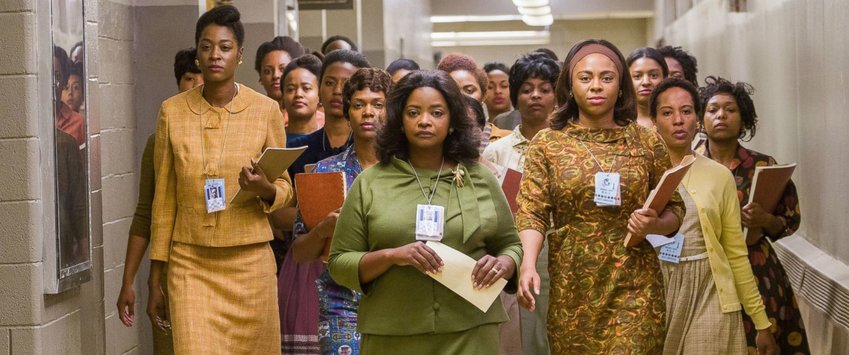
I judge films like “Hidden Figures” the toughest, because I can see how smart and well intentioned they are. But I can also see where they stumble, and filmmakers should see that, too. That’s why I’m, tough on films like this — not because they’re bad, but because they could be better, and they have no right not to be.
The primary purpose of “Hidden Figures” is to tell the story of its three protagonists, Katherine Johnson (Taraji P. Henson), Dorothy Vaughn (Octavia Spencer) and Mary Jackson (Janelle Monáe). The three were integral members of the team at NASA that helped launch John Glenn (Glen Powell) into space to orbit the Earth. Essentially, they helped the U.S. win the Space Race. But they were African-American women, and history has overlooked them, instead lauding the accomplishments of white men like Glenn. “Hidden Figures” seeks to remedy this. It isn’t so much an example of counter history, but of filling in the gaps of history. It gives the whole picture for the first time, asserting that black history is American history, not a separate, niche offshoot of it.
But the film never lets you forget that point, and feels far too proud of itself for doing so. Almost every scene in this film is there to serve the purpose of illustrating its didactic point. It’s a good point to make, but a movie isn’t supposed to be a history textbook, it’s supposed to be a work of art. And art is found in complexities and nuances, in how it can reflect our world back onto us. None of that is to be found in “Hidden Figures.” There’s no room for ambiguities. It reduces its characters to stereotypes and mouthpieces for modern political concerns. It would have been nice if the filmmakers had simply told the story as it was, and left the door open for viewers to arrive at the conclusion on their own.
It also panders to certain members of its audience. The film makes it far too easy for white audience members to write off the segregated reality it depicts as a thing of the past. It allows them to identify with characters like Glenn and Al Harrison (Kevin Costner), two “enlightened” white people, meant to act as models for a how a white person should handle racism. Most white viewers are going to see themselves as these two, without realizing that they would, given the cultural environment, likely be more like the casual racists Paul Stafford (Jim Parsons) or Vivian Mitchell (Kirsten Dunst). Ultimately, the films approach to race seems meant to alleviate the audiences’ white guilt. One of the most memorable and eye-roll-inducing scenes involves Costner’s character literally taking a crowbar to racist segregation.
But the film does have its virtues. There’s one scene with Spencer and Dunst that perfectly encapsulates the comforting lie that some white people tell themselves to avoid feeling guilt over their perpetuation and complicity in systemic racism.
And I’ll admit, the movie is entertaining as hell. The pacing is perfect and the three leads are exceptional. Spencer brings her trademark fierceness, Henson a determined pathos and Monáe, the film’s breakout performer, is buoyantly vibrant. They’re the best part of the film, and they lend personality and life to some very thin characters.
But “Hidden Figures” pats itself and its “progressive” audience on the back far too often. The film’s most moving moment is a photograph of the real life Johnson receiving the Presidential Medal of Freedom from President Obama. The image of a heroic black woman who overcame racism and segregation to help send humanity into space being honored by our nation’s first black president is undeniably powerful. If you know the tropes of historical films like this, you might have guessed that the photograph is shown over the end credits.
It’s emblematic of the film itself. What’s most potent and important about “Hidden Figures” isn’t anything in the actual movie, but the extra-textual history and politics that surround it. It’s a fine film, but few of it’s greatest virtues can actually be attributed to the film itself.
Support City Pulse - Donate Today!
Comments
No comments on this item Please log in to comment by clicking here